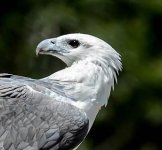dramtastic
Senior Member
The majestic sea eagle.


Last edited:



Nice shot, but is it my crappy work monitor or is the head area over exposed?
Great shots Brian. I agree that in harsh sunlight birds with contrasting B & W can be hard to expose for. I think you have done extremely well.

